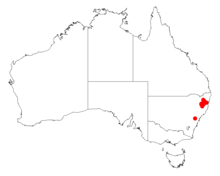| Ingram's wattle | |
|---|---|

| |
| Ingram's Wattle, Acacia ingramii, Wollomombi Falls, Oxley Wild Rivers National Park, NSW, Australia | |
| Scientific classification | |
| Kingdom: | Plantae |
| Clade: | Tracheophytes |
| Clade: | Angiosperms |
| Clade: | Eudicots |
| Clade: | Rosids |
| Order: | Fabales |
| Family: | Fabaceae |
| Subfamily: | Caesalpinioideae |
| Clade: | Mimosoid clade |
| Genus: | Acacia |
| Species: | A. ingramii
|
| Binomial name | |
| Acacia ingramii | |

| |
| Occurrence data from AVH | |
Acacia ingramii, commonly known as Ingram's wattle,[1] is a shrub belonging to the genus Acacia and the subgenus Phyllodineae that is native to parts of north eastern Australia.
Description[edit]
The shrub or tree typically grows to a height of 2 to 5 m (6 ft 7 in to 16 ft 5 in) and has a spreading bushy habit.[2] It has smooth grey bark that is corrugated towards the base of the plant. The angled or terete branchlets have covered in appressed whitish hairs and have yellowish silky new shoots. Like most species of Acacia it has phyllodes rather than true leaves. The evergreen, straight or slightly curved phyllodes have a linear shape and a length of 7 to 14 cm (2.8 to 5.5 in) and a width of 1.5 to 3.5 mm (0.059 to 0.138 in) and are covered in yellow or whitish appressed hairs. The phyllodes have a prominent midvein and obscure lateral veins with an acute apex.[1]
Taxonomy[edit]
The species was first formally described by the botanist Mary Tindale in 1978 as part of the work Notes on Australian taxa of Acacia as published in the journal Telopea. It was reclassified as Racosperma ingramii by Leslie Pedley in 2003 then returned to genus Acacia in 2006.[3] The specific epithet honours Cyril Keith Ingram who first recognised it as a new species.[1]
Distribution[edit]
The shrub has a limited distribution in upper basin of the Macleay River in New South Wales to the east of Armidale.[2] It is reasonably widespread in the escarpment gorges from around Apsley Falls to Wollomombi Falls and also in the Guy Fawkes River National Park usually in low woodland or open forest communities situated in steep country.[1]
See also[edit]
References[edit]
- ^ a b c d "Acacia ingramii Tindale". PlantNet. Royal Botanic Garden, Sydney. Retrieved 21 June 2020.
- ^ a b "Acacia ingramii". World Wide Wattle. Western Australian Herbarium. Retrieved 10 May 2019.
- ^ "Acacia ingramii Tindale". Atlas of Living Australia. Global Biodiversity Information Facility. Retrieved 21 June 2020.